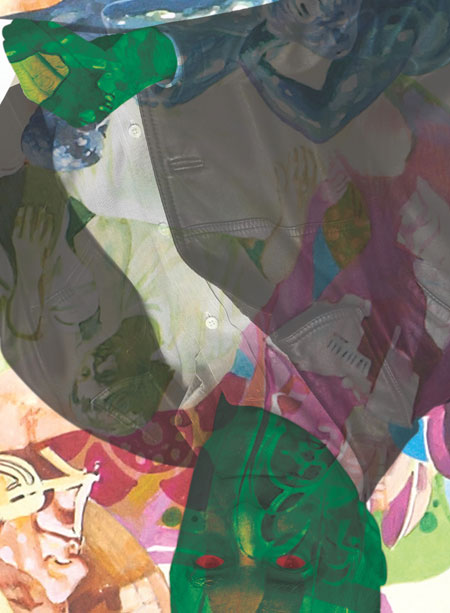the diogenes club dsastre
Many of you know Gipuzkoa Council’s KM Culture Centre. Let’s say that while you went there to study you spent hours looking at the unknown person who was sitting opposite you. Or when “world music” became fashionable you took out lots of CDs and recor ... that’s to say, listened to them. What’s more, they have and loan many famous people’s books there, or so people say. Recently, two new gems have been uncovered at KM. They have an unusual, exceptional taste to them. The collector is the collection
Before KM existed, books were taken out of the Council’s library using hard to understand paper cards. When we were studying, Luis Gasca was the director of Donostia Zinemaldia. As well as being a film fanatic, he was a passionate collector. His collections, like most collections, centred around his obsessions: images, comics, cinema ... Sometime, somehow, images which had become icons are the centre of that collection. Luis Gasca’s collection take us to the pop era and also to many cultural organizers who kept and valued things that would never have got into cultural institutions.
We want to highlight two pieces from the collection. Hundreds of files are categorized by subject. People, characters, subjects and films that were fashionable at one time. All the subjects that took Mr Gasca’s interest got their own files, full of images and press cuttings. The collector used pop and simple techniques to put together his collection. The things is, copy-paste hadn’t been invented then, or hardly ... His criteria were scissors, paper, glue and fans’ opinions. From that point of view, it’s a bit like a fanzine. Though it’s not a fan’s magazine, it is a mountain of files put together by a fan. You could say that he took the idea of a “fanzine” and made a “fanfile”.
Comics are the second indispensable part of Gasca’s collection. There too, the collector’s cultural life and interests are clear, always far from cultural institutions. It’s also clear that he wanted to collect productions from each era. That’s why we think that the most interesting comics in the collections are the originals from more that 50 years ago which the collector managed to bring together.
From Pop to Punk? From mass communication to self-edition
If the previous culture, which reflected ideas in an obvious way, had been despised because of that, the second series of ideas have also been looked down on because they’re invisible. If self-edition was despised, it was because the creators were anonymous. Though that’s not completely true. Individuals who want to share their curiosity with other people with the same curiosity are one of the axis of society. Napartheid’s year by year fanzine collection is also kept by the Council: Fanxinoteka. Going from youth centre to youth centre, it’s been kept at Arteleku for many years now. Now, reawakening the collection, Napartheid’s more than 5,000 fanzines from all over the world, from before the Internet, are kept at the Council.
These two collections invite many reflections about the idea of culture and, we believe, help us to understand to route from Pop to popular.
Before KM existed, books were taken out of the Council’s library using hard to understand paper cards. When we were studying, Luis Gasca was the director of Donostia Zinemaldia. As well as being a film fanatic, he was a passionate collector. His collections, like most collections, centred around his obsessions: images, comics, cinema ... Sometime, somehow, images which had become icons are the centre of that collection. Luis Gasca’s collection take us to the pop era and also to many cultural organizers who kept and valued things that would never have got into cultural institutions.
We want to highlight two pieces from the collection. Hundreds of files are categorized by subject. People, characters, subjects and films that were fashionable at one time. All the subjects that took Mr Gasca’s interest got their own files, full of images and press cuttings. The collector used pop and simple techniques to put together his collection. The things is, copy-paste hadn’t been invented then, or hardly ... His criteria were scissors, paper, glue and fans’ opinions. From that point of view, it’s a bit like a fanzine. Though it’s not a fan’s magazine, it is a mountain of files put together by a fan. You could say that he took the idea of a “fanzine” and made a “fanfile”.
Comics are the second indispensable part of Gasca’s collection. There too, the collector’s cultural life and interests are clear, always far from cultural institutions. It’s also clear that he wanted to collect productions from each era. That’s why we think that the most interesting comics in the collections are the originals from more that 50 years ago which the collector managed to bring together.
From Pop to Punk? From mass communication to self-edition
If the previous culture, which reflected ideas in an obvious way, had been despised because of that, the second series of ideas have also been looked down on because they’re invisible. If self-edition was despised, it was because the creators were anonymous. Though that’s not completely true. Individuals who want to share their curiosity with other people with the same curiosity are one of the axis of society. Napartheid’s year by year fanzine collection is also kept by the Council: Fanxinoteka. Going from youth centre to youth centre, it’s been kept at Arteleku for many years now. Now, reawakening the collection, Napartheid’s more than 5,000 fanzines from all over the world, from before the Internet, are kept at the Council.
These two collections invite many reflections about the idea of culture and, we believe, help us to understand to route from Pop to popular.



